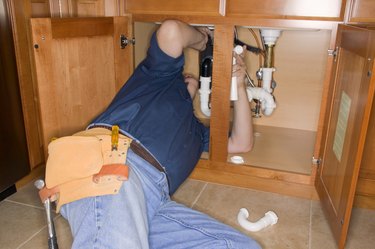
Mold is a fungus that can be found both indoors and outdoors. Indoor molds must be removed; they can cause adverse reactions in people ranging from mild symptoms such as eye irritation, wheezing, skin irritation and a stuffy nose to severe reactions such as shortness of breath and fever. Most people can control mold from becoming a serious hazard inside their homes by eliminating mold when it first appears and preventing it from becoming a serious hazard. But in vacant homes, controlling mold can be more difficult because there is no constant human presence to detect it.
How to Avoid Mold in a Vacant House
Video of the Day
Step 1
Fix any leaks and seepage, inside and out, as the most important ingredient for mold growth is damp environments. Eradicate leaks from sinks and showers by shutting off the main water valve outside.
Video of the Day
Step 2
Ventilate the home. Leave some windows cracked open if you feel it's safe to do so.
Step 3
Remove debris from the home, including clothing or other items left behind by tenants. Clothing and other remnants of human life may become moist, creating a hospitable environment for mold growth.
Step 4
Remove any plant life from the home. Mold can grow in plant soil.
Step 5
Clean out the refrigerator, throwing out any leftover food or debris. Wash it down thoroughly with with anti-fungal products, vinegar, or bleach and water if you have unplugged it.
Step 6
Get rid of any existing mold using a mold-removing product. Pay particular attention to the showers or bathtubs, where mold often grows.
Step 7
Turn off the water to the toilet and get rid of all the water in the bowl. Mold will grow inside the toilet bowl and underneath the toilet seat if water is present.
Step 8
Put plastic over dirt in crawl spaces and in the basement to help prevent mold growth. Also make sure crawl spaces and the basement are well-ventilated.